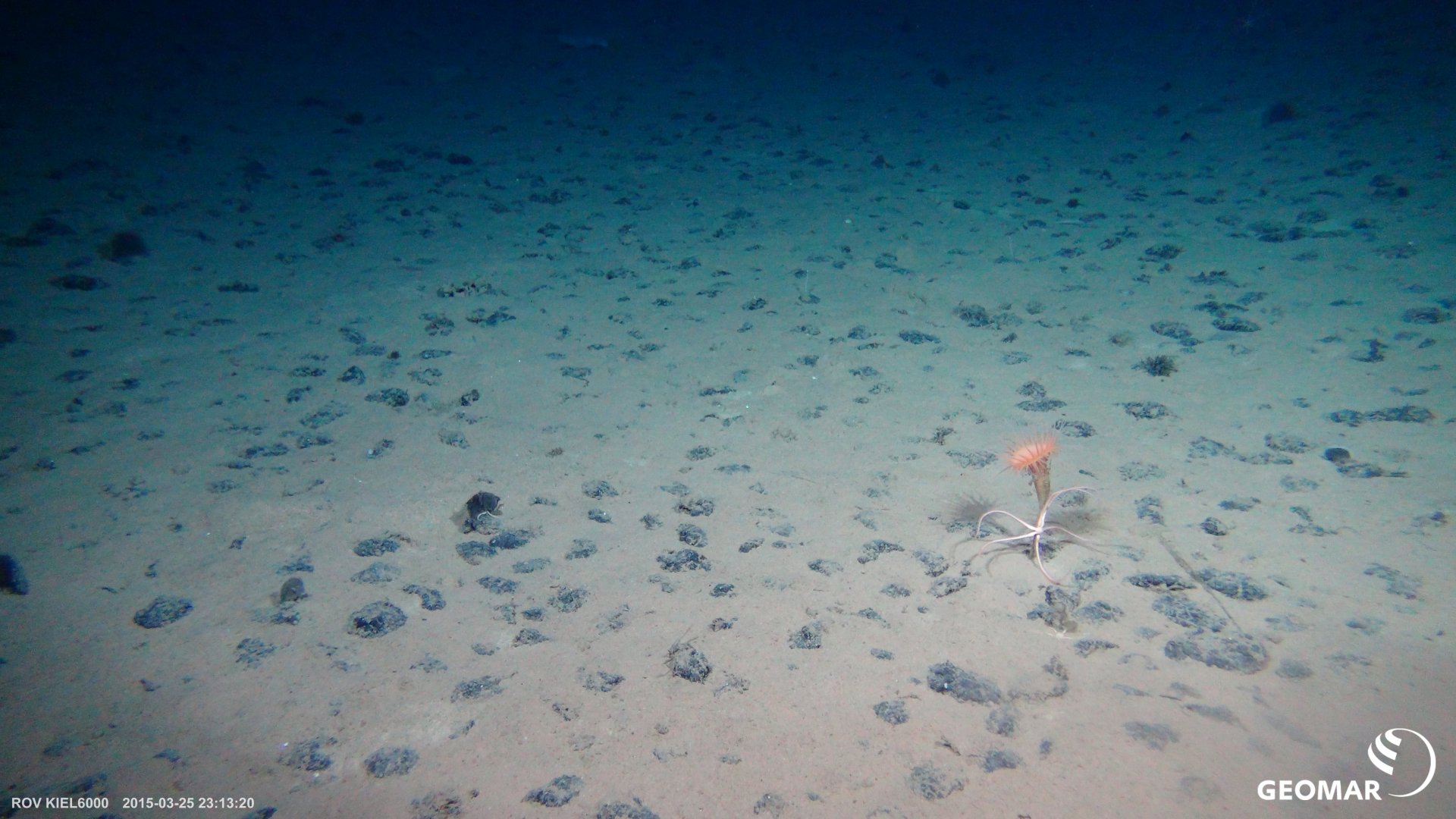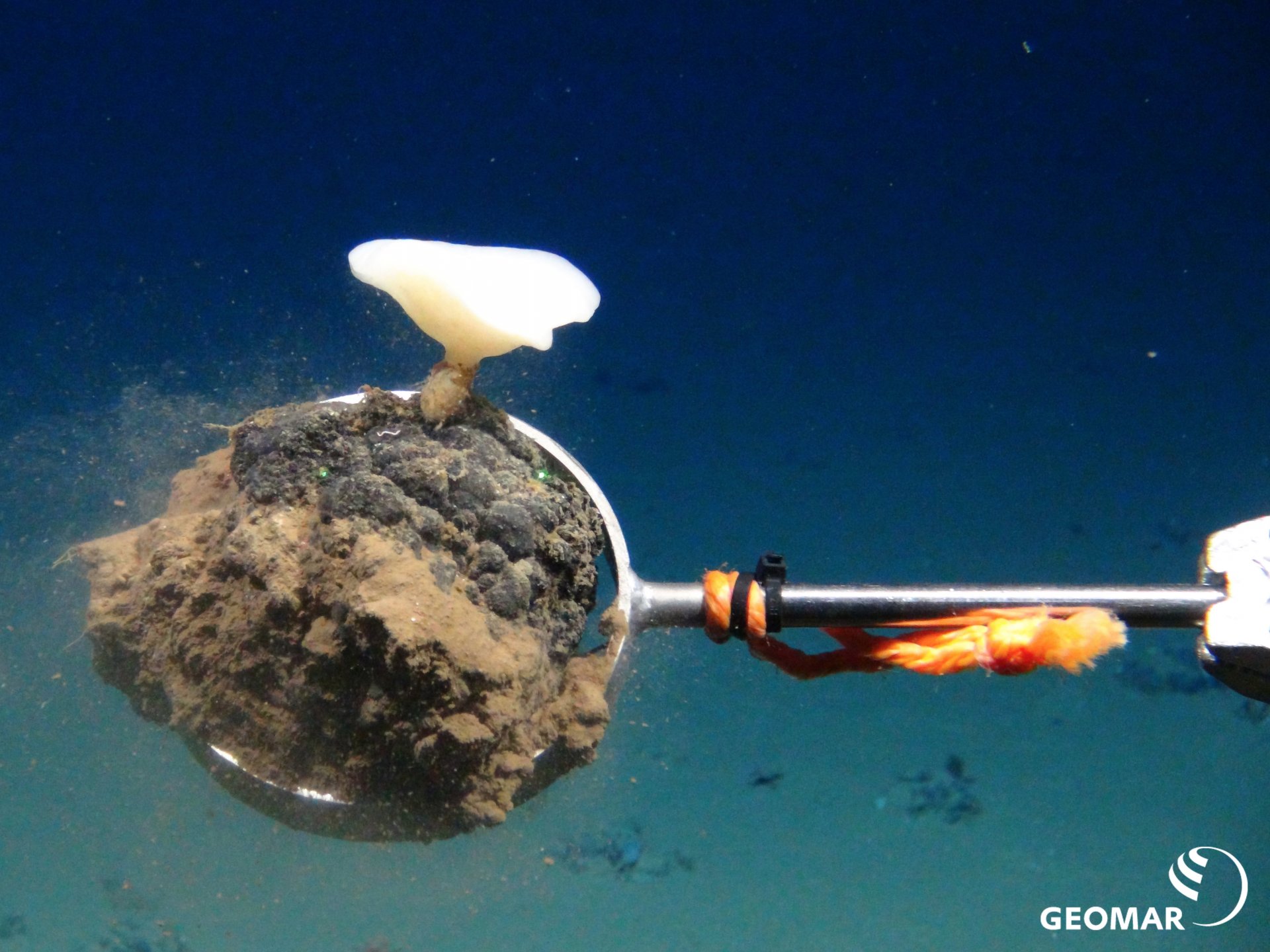- Press Office
- Press releases 2021
- Assessing the Impacts of Nodule Mining on the Deep-Sea Environment
Assessing the Impacts of Nodule Mining on the Deep-Sea Environment
The study sites of "MiningImpact" in the Clarion-Clipperton Fracture Zone (CCZ) are located in water depths of more than 4,000 meters and more than 1,500 kilometers off the Mexican coast. The CCZ is an area of five million square kilometers, where manganese nodules are highly abundant on the seafloor. Concentrated in these nodules are metals of economic interest for high-tech products used for energy transformation, mobility and telecommunication, such as copper, cobalt, and nickel.
This seabed area between Mexico and Hawaii lies outside the Exclusive Economic Zones of any country and is part of the common heritage of mankind. This common area is managed by the International Seabed Authority (ISA) based in Kingston, Jamaica, under the United Nations Convention on the Law of the Sea (UNCLOS), which has been joined by 167 countries and the European Union. The ISA is currently working on the exploitation regulations of the "Mining Code", which will form the legal framework for future deep-sea mining activities, and is being developed through an iterative process with several stakeholder consultations.
These international regulations should include stringent environmental standards, such as for establishing the environmental baseline, the monitoring of mining operations as well as threshold values for impacts and indicators of ecosystem health. To shape these regulations, scientific knowledge on the ecological impacts of deep-sea mining is urgently required. The JPI Oceans collaborative project “MiningImpact” is dedicated to contributing to the assessment of these impacts and to proposing solutions to prevent serious harm to the abyssal ecosystem.
The German Federal Institute for Geosciences and Natural Resources (BGR) has chartered the multi-purpose vessel Island Pride and invited “MiningImpact” partners to conduct their independent monitoring of a pre-prototype nodule collector test from this vessel. The Belgian company GSR has agreed to its activities being independently investigated and has worked closely with the scientists to give them access to all trial activities. These trials will take place in the Belgian and German contract areas of the CCZ.
“This offers the unique opportunity for us to collect, for the first time, quantitative scientific evidence on the environmental consequences of nodule extraction in a more realistic scenario than was previously possible” explains project coordinator Dr. Matthias Haeckel from GEOMAR Helmholtz Centre for Ocean Research Kiel. Investigations will not only address the direct impacts that the collector vehicle will produce by harvesting manganese nodules, but also those induced by the suspended sediment plume that is created by this process and affects a much larger area. The data will provide information on ecosystem effects of potential future mining that cannot be drawn from the small-scale benthic impact experiments conducted in the past.
At the same time a fully integrated monitoring approach will be tested that will inform future needs for the surveillance of human activities in the deep sea to ensure compliance with environmental standards and targets. “Employing state-of-the-art scientific equipment will allow us to determine the spread of the suspended sediment plume created by the vehicle harvesting the nodules as well as the blanketing of the adjacent seabed by resettling fallout from this plume. We will finally be able to put numbers to this type of impact”, says Dr. Henko De Stigter from the Royal Netherlands Institute for Sea Research (NIOZ), who is leading the plume sensor group on board.
Together with the manganese nodules the collector machine is expected to remove the top 10-15 centimeters of the seafloor and the fauna living on and within it. “In addition to surveying the loss of biodiversity across different faunal classes, our work also includes studies on biogeochemical fluxes, microbial turnover rates and ecosystem functioning, in-situ ecotoxicology, release of trace metals from the suspended sediment plume as well as emissions of noise and light by the collector vehicle and much more”, says Dr. Haeckel to summarize the main goals of the expedition.
Among the specialized instruments that will be deployed are two remotely-operated vehicles (ROV), an autonomous underwater vehicle (AUV), in situ oxygen profilers and experiment chambers, in situ pumps as well as fifty inter-calibrated hydro-acoustic and optical sensors for measuring the suspended sediment concentrations and particle sizes.The JPI Oceans project "MiningImpact” has investigated the ecological consequences of deep-sea mining and how the impacts may be mitigated since 2015. It included an assessment of decade-old tracks of previous studies as well as small experiments to understand the interaction between nodule removal and the responses of deep-sea life.
The first phase, which is already completed, provided substantial first insights into the expected longer-term effects of deep-sea mining. Now, in the second phase, the scientists plan to conduct a comprehensive monitoring of the immediate environmental impacts of the first test of an industrial collector pre-prototype in real-time. The first attempt to test the collector by GSR in spring 2019 did not take place due to a technical failure of the power and communication cable to this instrument. “The research of the MiningImpact consortium is extremely important and essential to ensure that the marine environment in the deep sea will be protected according to highest possible standards”, says Professor Katja Matthes, Director of GEOMAR. “The results of this project will provide the scientific evidence that is urgently needed by the International Seabed Authority as input for improved environmental standards and guidelines of the Mining Code”, Matthes continues.
After twelve days of self-isolation in a hotel in San Diego and repeated Covid-19 PCR tests the scientists are ready to embark on the expedition that is carried out under strict hygiene conditions.
This is a joint press release of GEOMAR Helmholtz Centre for Ocean Research Kiel, Alfred-Wegener Institute Helmholtz Centre for Polar and Marine Research, Senckenberg-Gesellschaft für Naturforschung, Jacobs University Bremen gGmbH, MARUM - Center for Marine Environmental Sciences at the University of Bremen, Max-Planck Institute for Marine Microbiology, Royal Netherlands Institute for Sea Research, Utrecht University, Ifremer, Ghent University, Universidade de Aveiro, Institute of Marine Research at Açores, Instituto Português do Mar e da Atmosfera, Centre for Marine and Environmental Research at Universidade do Algarve, Interdisciplinary Centre of Marine and Environmental Research at Universidade do Porto, Biodata Mining Group at University of Bielefeld, SNF Centre for Applied Research at NHH, German Research Alliance, Joint Programming Initiative Healthy Seas and Oceans
Background: MiningImpact - Environmental impacts and risks of deep-sea mining
The second project phase of “MiningImpact” (2018-22), builds on the first phase and addresses three major research foci concerning deep-sea mining: (1) the larger scale environmental impact caused by the suspended sediment plume, (2) the regional connectivity of species and the biodiversity of biological assemblages and their resilience to impacts, and (3) the integrated effects on ecosystem functions, such as the benthic foodweb and biogeochemical processes.
The “MiningImpact” project is conducted independently of DEME-GSR’s activities and does not receive any financial contributions from DEME-GSR. Conversely, DEME-GSR does not receive any funding from the “MiningImpact” project. DEME-GSR is also conducting its own monitoring programme aboard its vessel.
Funding for the project was provided under the framework of the Joint Programming Initiative Healthy Seas and Oceans (JPI Oceans) by:
- Belgian Science Policy Office (BELSPO) and Flanders EWI Department, Belgium
- The Federal Ministry for Education and Research (BMBF), Germany
- Research Council of Norway (RCN), Norway
- The Netherlands Organization for Scientific Research (NWO), The Netherlands
- Fundação para a Ciência e a Tecnologia (FCT) and Direção-Geral de Política do Mar (DGPM), Portugal
Links
https://miningimpact.geomar.de MiningImpact project website
https://miningimpact.geomar.de/events Stakeholder information event for the cruise
http://jpi-oceans.eu/ecological-aspects-deep-sea-mining JPI Oceans website
https://www.allianz-meeresforschung.de German Marine Research Alliance
Participating institutions
- https://www.awi.de Alfred-Wegener Institute Helmholtz Centre for Polar and Marine Research
- https://www.senckenberg.de/de/institute/sam/dzmb Deutsches Zentrum für Marine Biodiversitätsforschung, Senckenberg am Meer
- https://www.geomar.de GEOMAR Helmholtz Centre for Ocean Research Kiel
- https://www.jacobs-university.de Jacobs University Bremen gGmbH
- https://www.marum.de MARUM - Center for Marine Environmental Sciences at the University of Bremen
- https://www.mpi-bremen.de/ Max-Planck Institute for Marine Microbiology
- https://www.nioz.nl Royal Netherlands Institute for Sea Research
- https://www.uu.nl Utrecht University
- https://www.ifremer.fr Ifremer
- https://www.ugent.be Ghent University
- http://www.cesam.ua.pt Centre for Environmental and Marine Studies, University of Aveiro
- https://imar.org.pt Institute of Marine Research Okeanos, University of the Azores
- https://www.ipma.pt Portuguese Institute for Sea and Atmosphere
- http://www.cima.ualg.pt Centre for Marine and Environmental Research, University of Algarve
- https://www2.ciimar.up.pt Interdisciplinary Centre of Marine and Environmental Research
- https://biodatamining.cebitec.uni-bielefeld.de Biodata Mining Group at University of Bielefeld
- https://snf.no Centre for Applied Research at NHH
Further Readings
Boetius A., Haeckel M. (2018) Mind the seafloor. Science 359(6371), doi: 10.1126/science.aap7301
https://science.sciencemag.org/content/359/6371/34
Vanreusel A., Hilario A., Ribeiro P.A., Menot L., Martinez-Arbizu P. (2016) Threatened by mining, polymetallic nodules are required to preserve abyssal epifauna. Scientific Reports 6, doi:10.1038/srep26808
https://www.nature.com/articles/srep26808
Biogeosciences Special Issue: Assessing environmental impacts of deep-sea mining – revisiting decade-old benthic disturbances in Pacific nodule areas
Images
Please ask the GEOMAR press office for images
Please direct your queries to:
The project is coordinated by GEOMAR Helmholtz Centre for Ocean Research Kiel.
Contact to the GEOMAR press office:
Dr. Andreas Villwock
Phone: +49-431 600-2802

